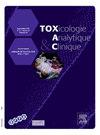External contamination of hair: Still a debate?
IF 1.7
Q4 TOXICOLOGY
引用次数: 0
Abstract
Objective
This study aims to explore the mechanisms behind external contamination in hair drug testing. Specifically, it investigates how external contamination can be detected, quantified, and differentiated from internal drug use. Ultimately, the study addresses whether contamination continues to pose a significant concern in forensic toxicology.
Introduction
Hair drug testing is commonly used in forensic toxicology to detect long-term substance abuse, offering the advantage of a prolonged detection window for drugs and metabolites. A major challenge in hair analysis is external contamination, which occurs when drug residues from environmental exposure or direct contact with substances like cocaine or cannabis are deposited onto the hair. This can lead to false-positive results, complicating test interpretation. The debate continues on whether external contamination is a real concern or just an artifact of testing. Some argue that proper washing and metabolite-to-parent drug ratios can distinguish contamination from internal use, while others believe contamination obscures the true source of the substances detected.
Material and methods
The study analysed hair samples from individuals with occupational drug exposure and judicial cases where drug use was suspected. These were tested using validated methods for detecting substances like cocaine, amphetamines, and opiates. The hair was segmented, washed with dichloromethane, water, and methanol to remove external contamination, then dried, pulverized, and extracted with acidified methanol using ultrasonic assistance. The extracted drugs were filtered, evaporated, reconstituted, and analysed using liquid chromatography-tandem mass spectrometry (LC-MS/MS).
Results
In the study, 96% of hair samples from individuals with occupational exposure to drugs tested positive for external contamination. Even after multiple washes with dichloromethane, water, and methanol, contamination remained, indicating that external sources may significantly contribute to the drug levels detected in hair samples. One notable case involved a hair sample from an individual who had a single environmental exposure to cocaine. This sample showed a concentration up to 292 pg/mg of cocaine, suggesting that even a single exposure to a drug could lead to detectable contamination in hair.
Among 596 judicial hair samples tested, 53% exhibited signs of external contamination. In 6.7% (12 samples) of these contaminated cases had more than 10% of the drug concentration remaining in the final methanol wash, pointing to the predominance of external contamination. In these cases, the presence of metabolites and additional corroborative biological tests (such as urine or blood tests) helped support the hypothesis that drug ingestion had occurred. However, in 3% of cases with significant external contamination, there was insufficient additional evidence to confirm internal drug use. This issue was particularly apparent in cases involving amphetamine and MDMA, substances that lack distinctive metabolites that could definitively indicate internal drug use.
Conclusion
Despite the application of comprehensive washing protocols, completely eliminating contamination from hair samples remains a challenge. This study emphasizes the importance of interpreting hair drug test results carefully, considering not only the washing procedures used but also the presence of metabolites, which can help distinguish internal drug use from external contamination. Relying solely on cut-off values without accounting for the possibility of contamination could lead to misinterpretation, especially in laboratories with limited experience in hair analysis. The findings indicate that while external contamination is a real concern, its effects can be mitigated through the use of comprehensive testing protocols and careful interpretation of results in the context of additional biological and case-specific information.
Future research should focus on standardizing contamination detection methods across laboratories to reduce variability and improve consistency in results which will also help laboratories with less experience in hair analysis avoid misinterpretations that could have serious legal and forensic implications.
头发的外部污染:还在争论吗?
目的探讨毛发药物检测中外源污染的影响机制。具体来说,它研究了如何检测、量化和区分外部污染与内部用药。最后,该研究解决了污染是否继续在法医毒理学中引起重大关注。毛发药物检测通常用于法医毒理学检测长期药物滥用,为药物和代谢物提供了延长检测窗口的优势。头发分析的一个主要挑战是外部污染,当环境暴露或直接接触可卡因或大麻等物质的药物残留沉积在头发上时,就会发生这种情况。这可能导致假阳性结果,使测试解释复杂化。关于外部污染是一个真正的问题还是仅仅是测试的产物的争论仍在继续。一些人认为,适当的洗涤和代谢物与母体药物的比例可以区分污染和内部使用,而另一些人则认为污染掩盖了检测到的物质的真正来源。材料和方法本研究分析了职业药物接触者和涉嫌使用药物的司法案件的头发样本。这些药物是用经过验证的方法检测可卡因、安非他命和鸦片等物质的。将头发分段,用二氯甲烷、水和甲醇洗涤以去除外部污染,然后用超声波辅助酸化甲醇干燥、粉碎和提取。提取的药物经过滤、蒸发、重组,用液相色谱-串联质谱(LC-MS/MS)分析。结果在本研究中,96%的职业药物接触者的头发样本检测为外部污染阳性。即使在用二氯甲烷、水和甲醇多次洗涤后,污染仍然存在,这表明外部来源可能对头发样本中检测到的药物水平有很大影响。一个值得注意的案例涉及一个人的头发样本,他只在一个环境中接触过可卡因。该样本显示可卡因的浓度高达292 pg/mg,这表明即使一次接触毒品也可能导致头发中可检测到的污染。在接受检测的596份司法人员头发样本中,53%显示出外部污染的迹象。在这些污染病例中,有6.7%(12个样本)的最终甲醇洗涤中残留的药物浓度超过10%,表明外部污染占主导地位。在这些病例中,代谢物的存在和额外的确证生物学测试(如尿液或血液测试)有助于支持发生了药物摄入的假设。然而,在3%的严重外部污染病例中,没有足够的额外证据来确认内部用药。这一问题在涉及安非他明和MDMA的案件中尤为明显,这两种物质缺乏能够明确表明内服药的独特代谢物。结论尽管采用了全面的洗涤方案,但完全消除头发样本中的污染物仍然是一个挑战。这项研究强调了仔细解释头发药物测试结果的重要性,不仅要考虑使用的洗涤程序,还要考虑代谢物的存在,这可以帮助区分内部药物使用和外部污染。仅依赖临界值而不考虑污染的可能性可能导致误解,特别是在头发分析经验有限的实验室。研究结果表明,虽然外部污染确实令人担忧,但可以通过使用全面的测试方案和根据额外的生物学和具体病例信息仔细解释结果来减轻其影响。未来的研究应侧重于标准化实验室间的污染检测方法,以减少结果的可变性和提高结果的一致性,这也将帮助在头发分析方面经验较少的实验室避免可能产生严重法律和法医影响的误解。
本文章由计算机程序翻译,如有差异,请以英文原文为准。
求助全文
约1分钟内获得全文
求助全文

 求助内容:
求助内容: 应助结果提醒方式:
应助结果提醒方式:


